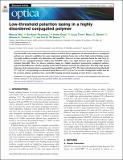Files in this item
Low-threshold polariton lasing in a highly disordered conjugated polymer
Item metadata
| dc.contributor.author | Wei, Mengjie | |
| dc.contributor.author | Rajendran, Sai Kiran | |
| dc.contributor.author | Ohadi, Hamid | |
| dc.contributor.author | Tropf, Laura Christine | |
| dc.contributor.author | Gather, Malte C. | |
| dc.contributor.author | Turnbull, Graham A. | |
| dc.contributor.author | Samuel, Ifor D. W. | |
| dc.date.accessioned | 2019-08-28T11:30:05Z | |
| dc.date.available | 2019-08-28T11:30:05Z | |
| dc.date.issued | 2019-08-27 | |
| dc.identifier | 260558942 | |
| dc.identifier | c26dfc1b-47e9-412e-be98-ebbd669e90e2 | |
| dc.identifier | 85073374146 | |
| dc.identifier | 000487275900005 | |
| dc.identifier.citation | Wei , M , Rajendran , S K , Ohadi , H , Tropf , L C , Gather , M C , Turnbull , G A & Samuel , I D W 2019 , ' Low-threshold polariton lasing in a highly disordered conjugated polymer ' , Optica , vol. 6 , no. 9 , 362590 , pp. 1124-1129 . https://doi.org/10.1364/OPTICA.6.001124 | en |
| dc.identifier.issn | 2334-2536 | |
| dc.identifier.other | ORCID: /0000-0002-4857-5562/work/61133162 | |
| dc.identifier.other | ORCID: /0000-0001-6418-111X/work/61133236 | |
| dc.identifier.other | ORCID: /0000-0002-9079-120X/work/100172734 | |
| dc.identifier.uri | https://hdl.handle.net/10023/18386 | |
| dc.description | Funding. China Scholarship Council; Engineering and Physical Sciences Research Council (EP/L015110/1, EP/M025330/1). | en |
| dc.description.abstract | Low-threshold, room-temperature polariton lasing is crucial for future application of polaritonic devices. Conjugated polymers are attractive candidates for room-temperature polariton lasers, due to their high exciton binding energy, very high oscillator strength, easy fabrication, and tunability. However, to date, polariton lasing has only been reported in one conjugated polymer, ladder-type MeLPPP, whose very rigid structure gives an atypically narrow excitonic linewidth. Here, we observe polariton lasing in a highly disordered prototypical conjugated polymer, poly(9,9-dioctylfluorene), thereby opening up the field of polymer materials for polaritonics. The long-range spatial coherence of the emission shows a maximum fringe visibility contrast of 72%. The observed polariton lasing threshold (27.7 μJ/cm2, corresponding to an absorbed pump fluence of 19.1 μJ/cm2) is an order of magnitude smaller than for the previous polymer polariton laser, potentially bringing electrical pumping of such devices a step closer. | |
| dc.format.extent | 6 | |
| dc.format.extent | 1455462 | |
| dc.language.iso | eng | |
| dc.relation.ispartof | Optica | en |
| dc.subject | QC Physics | en |
| dc.subject | DAS | en |
| dc.subject.lcc | QC | en |
| dc.title | Low-threshold polariton lasing in a highly disordered conjugated polymer | en |
| dc.type | Journal article | en |
| dc.contributor.sponsor | EPSRC | en |
| dc.contributor.sponsor | EPSRC | en |
| dc.contributor.institution | University of St Andrews. School of Physics and Astronomy | en |
| dc.contributor.institution | University of St Andrews. Sir James Mackenzie Institute for Early Diagnosis | en |
| dc.contributor.institution | University of St Andrews. Centre for Biophotonics | en |
| dc.contributor.institution | University of St Andrews. Biomedical Sciences Research Complex | en |
| dc.contributor.institution | University of St Andrews. Condensed Matter Physics | en |
| dc.identifier.doi | 10.1364/OPTICA.6.001124 | |
| dc.description.status | Peer reviewed | en |
| dc.identifier.url | https://www.osapublishing.org/optica/abstract.cfm?uri=optica-6-9-1124&origin=search#articleSupplMat | en |
| dc.identifier.grantnumber | EP/L015110/1 | en |
| dc.identifier.grantnumber | EP/M025330/1 | en |
This item appears in the following Collection(s)
Items in the St Andrews Research Repository are protected by copyright, with all rights reserved, unless otherwise indicated.

